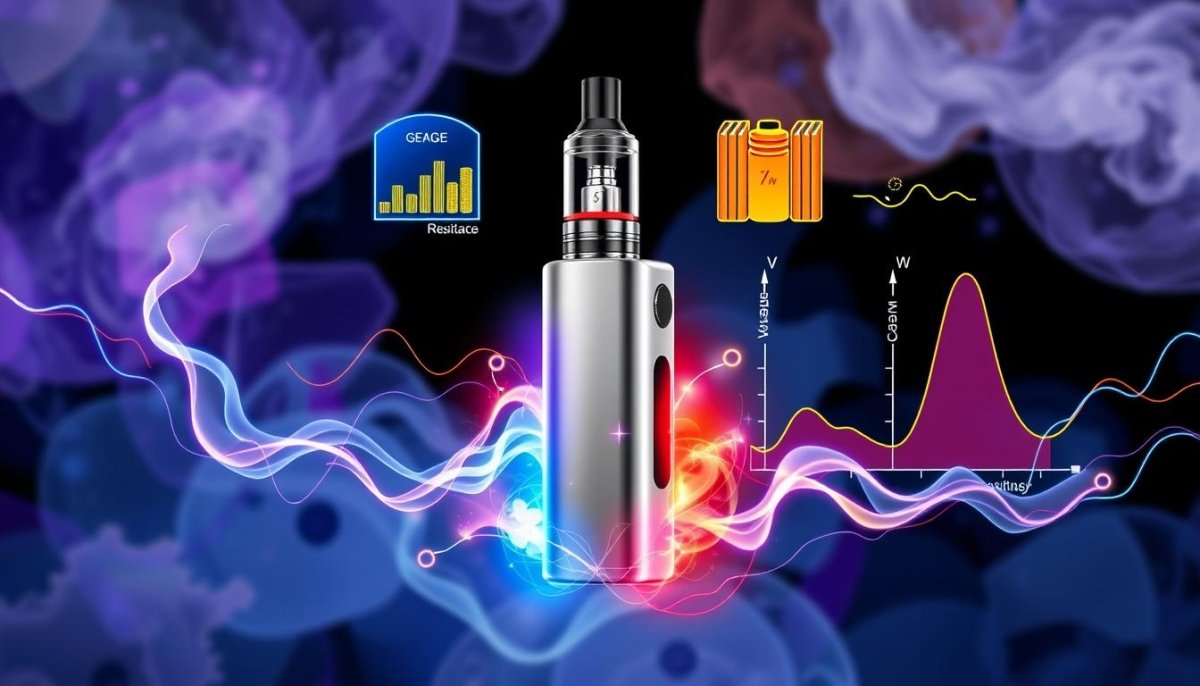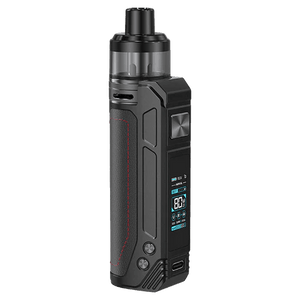Understanding Ohm's Law in Vaping | Beginner's Guide

Understanding Ohm's Law in Vaping | Beginner's Guide
Did you know a typical vape coil setup can produce 300 watts of power? Ohm's Law is key to unlocking your vaping potential. It helps you understand voltage, current, and resistance. This knowledge lets you optimise your device, improve flavour and vapour, and stay safe.
Key Takeaways
- Ohm's Law describes the crucial relationship between voltage, current, and resistance in electrical circuits.
- Applying Ohm's Law helps vapers calculate the appropriate wattage settings for their devices and atomizers.
- Understanding Ohm's Law is essential for building safe and effective coils, especially for sub-ohm vaping.
- Knowing how Ohm's Law works allows vapers to troubleshoot issues and optimise their vaping experience.
- Mastering Ohm's Law is a fundamental step in becoming a more informed and responsible vaper.
What is Ohm's Law?
Ohm's Law is a key rule in electrical engineering. It links vaping voltage, vaping current, and vape coil resistance. It was discovered by German physicist Georg Ohm. He found that the current in a circuit depends on the voltage and the circuit's resistance.
Definition of Ohm's Law
Ohm's Law is simple: I = V/R. Here, I is the current, V is the voltage, and R is the resistance. This formula helps us understand and work with electrical circuits, like those in vaping devices.
Importance in Electrical Circuits
- Ohm's Law is vital for vaping, especially for those making their own coils with Rebuildable Atomisers (RDAs).
- For new vapers using disposable, pod systems, or basic vape pens, it's not as crucial. These devices are made to work safely with the battery and coil.
- But, for advanced vapers, knowing Ohm's Law is key. It ensures their devices work safely and well.
Understanding Ohm's Law helps vapers figure out the current, voltage, and resistance in their setups. This is important for keeping batteries safe and getting the best vaping experience.
How Ohm's Law Applies to Vaping
Ohm's Law is key for vaping. It was named after German physicist Georg Ohm. It shows how voltage, current, and resistance work together in electrical circuits. For vaping, it helps find the best settings for devices, keeping them safe and working well.
Voltage, Current, and Resistance Explained
Ohm's Law says current (I) is directly related to voltage (V) and inversely related to resistance (R). This is shown as I = V/R. In vaping, the device's power depends on battery voltage, coil resistance, and circuit current.
Real-life Applications in Vaping Devices
- Vape batteries, like the 18560 Lithium-ion, have a fixed voltage of 3.6V. This is important for Ohm's Law.
- Vape coils have specific resistance values, from 0.2Ω to 3.0Ω. These affect power output and vapour quality.
- Knowing about battery safety in vaping and vaping resistance is vital for advanced vapers. It helps them get the best vaping experience and keep their devices safe.
Regulated box mod devices have safety chips to prevent over-powering. By using Ohm's Law, vapers can figure out safe current draw. This is true for any coil type.
"Ohm's Law is crucial for calculating safe current draw from batteries and preventing device malfunctions."
Whether you're using an RDA or making your own coils, knowing Ohm's Law is vital. It lets vapers get the most out of their vape kits safely. By understanding this, vapers can enjoy their devices fully and safely.
Key Terms to Know
Exploring vaping means learning about Ohm's Law terms. These basics help you understand your vaping device better. They also improve your vaping experience.
Ohm (Ω)
The Ohm (Ω) measures electrical resistance. In vaping, it shows the coil's resistance. This resistance affects the current and power of your device.
Watt (W)
The Watt (W) measures power, or energy use. In vaping, your device's wattage controls the vape's intensity. It changes the heat and vapour produced.
Volt (V)
The Volt (V) measures electrical potential difference. In vaping, your device's voltage is key. It impacts performance and safety.
Ampere (A)
The Ampere (A) measures electrical current. Knowing the current in your device is vital. It ensures safe and optimal use.
Learning these terms helps you customise your vaping setup. It improves your device's performance and keeps you safe while vaping.
The Relationship Between Voltage, Current, and Resistance
For vapers, knowing how voltage, current, and resistance work together is key. Ohm's Law helps you tweak these factors for better vaping. You can get more vapour, better flavour, or longer battery life.
Ohm's Law Formula
The Ohm's Law formula is simple but powerful. It shows how voltage (V), current (I), and resistance (R) are linked. The formula is V = I × R. You can change it to find any variable if you know the others.
Understanding the Triangle
The Ohm's Law triangle makes it easy to see how these elements connect. Each side is a variable. Cover one side to find the formula for the other two.
Learning Ohm's Law and the triangle helps vapers make better choices. You can pick the right coil resistance and set the best wattage or voltage. This ensures safe, efficient, and fun vaping.
"Understanding Ohm's Law is the foundation for optimising your vaping setup and unlocking the full potential of your device."
The Impact of Resistance in Coils
Resistance is key in vaping, affecting how well you vape. The coil's resistance, in Ohms (Ω), changes power, vapour, and flavour. Knowing about resistance helps vapers get the vaping they want.
Lower Resistance vs. Higher Resistance
Sub-ohm coils (less than 1Ω) let more current flow. This means more power and vapour, and often stronger flavour. Higher resistance coils (1Ω and above) use less power, saving battery and e-liquid.
Importance of Coil Material
The coil's material greatly affects its resistance and vaping. Materials like Kanthal, Nichrome, and Stainless Steel each have their own effects. Choosing the right material is crucial for the best vaping experience.
| Coil Material | Resistance Range | Heating Characteristics | Flavour Impact |
|---|---|---|---|
| Kanthal | 0.2Ω - 1.5Ω | Moderate ramp-up time, consistent heating | Muted, smooth flavour |
| Nichrome | 0.1Ω - 1.0Ω | Faster ramp-up time, can produce hot spots | Bolder, more pronounced flavour |
| Stainless Steel | 0.2Ω - 1.5Ω | Moderate ramp-up time, even heat distribution | Crisp, clean flavour |
Understanding resistance in vape coils helps vapers improve their vaping. By trying different materials and resistances, they can find their ideal vaping experience.
Selecting the Right Coil for Your Device
Choosing the right coil resistance is key to a great vaping experience. The coil's resistance, measured in Ohms (Ω), affects vapour production, flavour, and satisfaction. As a beginner, knowing what to look for in a coil is crucial.
Factors to Consider
Several factors influence your coil choice. First, make sure it fits your vape device. This info is usually in the manual or on the manufacturer's website. Next, think about your vaping style. Do you prefer mouth-to-lung (MTL) or direct-to-lung (DTL)? MTL needs higher resistance coils, while DTL works better with lower resistance coils.
The coil material also matters. You'll find coils made from kanthal, stainless steel, nickel, and titanium. Each has its own benefits and performance. Also, check the coil's wattage range to vape safely and enjoyably.
Recommendations for Beginners
Beginners should start with higher resistance coils (above 1.0 Ω). These coils are smoother and more controlled. They're great for mouth-to-lung devices and high-PG or 50/50 e-liquids. As you get more experience, you can try lower resistance coils for more vapour and flavour.
Always check that your coil's resistance and wattage match your device. Look at the manufacturer's guidelines and use a Coil Finder Tool for the best match.
| Coil Resistance Range | Vaping Style | Recommended E-liquid |
|---|---|---|
| 0.1 - 0.6 Ω | Sub-Ohm, Direct-to-Lung (DTL) | High-VG |
| 0.6 - 1.0 Ω | Restricted Direct-to-Lung (RDTL) | 50/50 and Higher-VG |
| 1.0 - 1.4 Ω | Mouth-to-Lung (MTL) | High-PG, 50/50, Nic Salts |
Finding the right coil can greatly improve your vaping. Take the time to understand the factors and recommendations to find the perfect coil for you.
Calculating Wattage in Vaping
Wattage (W) is key in vaping, as it shows how much power your device uses. It's important to calculate wattage to get the best performance and safety. The Ohm's Law formula helps: W = V² / R. Here, V is the voltage and R is the coil's resistance.
Understanding the Wattage Equation
The wattage equation helps you set the right power for your coils. Knowing this formula lets you choose the best voltage and resistance. This improves your vaping experience.
Safe Wattage Levels for Different Coils
The right wattage depends on the coil's resistance. Lower resistance coils need more power, while higher resistance ones use less. Start with the lower end of the recommended range and increase slowly to find the best setting.
For example, a 4.2-volt battery with a 0.5-ohm coil gives 35.3 watts. But, with 3.7 volts, the wattage drops to 27.3 watts. This shows how voltage and resistance affect wattage.
Knowing how voltage, resistance, and wattage work together helps vapers use their devices safely and effectively. This improves their vaping experience.
Using a Vape Mod's Settings
Vaping lets users change their experience in many ways. They can adjust the voltage and temperature settings. This helps them get the best out of their vape.
Variable Voltage Mods
Variable voltage mods let users control the power. Changing the voltage affects the coil's temperature and vapour. It's great for those who want to try different e-liquids and coils.
Temperature Control Features
Temperature control (TC) mods work differently. They keep the coil at a steady temperature. This prevents dry hits and keeps the flavour smooth. It's good for those who care about flavour and want to make their coils last longer.
Knowing about regulated and unregulated vape mods and vaping voltage is key. It helps vapers get the most out of their devices. By learning about these settings, users can make their vaping experience better and safer.
Safety Precautions with Ohm's Law
Ohm's Law is key in vaping to stop overheating and battery failures. It's important to know how resistance affects your device. Using the wrong resistance can damage your vape or cause it to vent.
Avoiding Overheating
To prevent overheating, use batteries within their amp rating. Also, avoid low-resistance coils unless you have a regulated mod. The formula I=V/R helps calculate current and keeps it safe.
Risks of Incorrect Resistance
- Sub-ohm vaping, with resistance under 1 ohm, increases current and vapour. It also strains the battery more.
- Pushing a battery too hard can cause it to vent hot chemicals. This can lead to an explosion.
- Using a good Ohm's meter, like the Coil Master 521 Tab or Geekvape 521 Tab, ensures accurate readings. This prevents battery safety in vaping and vape ohm's law issues.
By using Ohm's Law right, vapers can make their devices safer and better. This ensures a safe and fun vaping experience.
The Role of Batteries in Vaping
Batteries are key in vaping, powering our devices for safe, reliable use. It's vital to know the battery specs and pick the right one for your mod.
Battery Ratings and Specifications
Battery capacity is measured in milliamp hours (mAh). Higher mAh means longer battery life. The amp (A) rating shows the safe current draw, crucial for vaping current-intensive activities like sub-ohm vaping.
The 18650 Lithium-ion battery is the standard for advanced vape kits. It has a 3.6V nominal voltage. This battery balances power, capacity, and safety for experienced vapers.
Choosing the Right Battery for Your Mod
Choosing the right battery for your device is key. Consider the battery and mod specs. Common sizes are 18650, 20700, and 21700, each suited for different vaping needs.
- Integrated batteries in pod kits and vape pens last 6 months to a year.
- Replaceable batteries in larger mods last longer, up to 500 charge cycles.
- Variable wattage (VW) batteries let you adjust power for the best battery safety in vaping and performance.
Always use high-quality batteries from trusted makers. Follow charging, storage, and safety tips for a safe vaping experience.
Understanding Sub-Ohm Vaping
In the vaping world, sub-ohm vaping is very popular. It uses coils with a resistance under 1.0 ohm. This method creates lots of vapour and strong flavours. But, it also has risks that vapers need to know about.
Definition and Benefits
Sub-ohm vaping uses coils with a resistance of 0.5 to 1.0 ohms. This low resistance means more power and warmer vapour. Many find it more satisfying, with a stronger nicotine hit and better flavours.
Potential Risks and Considerations
Sub-ohm vaping has many benefits but also risks. Devices use more e-liquid, which can be expensive. They also drain batteries faster, needing more charges or bigger batteries.
Safety is key with sub-ohm vaping. Using it wrong or faulty gear can cause overheating and explosions. Always use regulated mods and take care of your vaping gear.
In short, knowing about sub-ohm vaping is important for a better vaping experience. Being aware of the good and bad helps vapers enjoy sub-ohm vaping safely and fully.
Troubleshooting Common Issues
Vaping fans sometimes face issues like uneven vapour, burnt tastes, and device problems. These problems often stem from wrong resistance or power settings. Luckily, with some troubleshooting and Ohm's Law, you can fix many of these issues.
Identifying Problems with Ohm's Law
One big issue is when vapour production is not even. This can be due to old coils, the type of e-liquid, or the voltage. Keeping coils fresh, using e-liquids with more VG, and adjusting airflow and voltage can help.
Another common problem is a burnt taste. This might mean the coil is too hot or the e-liquid is too dry. Make sure the coil is well-soaked in e-liquid and control the voltage to avoid dry hits and burnt flavours.
Solutions for Common Vaping Problems
- Adjust wattage or voltage settings to find the optimal power level for your coil resistance.
- Replace coils regularly to maintain consistent performance and flavour.
- Check battery connections and ensure compatibility between your mod and tank to avoid compatibility issues.
- Monitor e-liquid levels and refill your tank as needed to prevent leaks and dry hits.
- Familiarise yourself with common error messages, such as 'atomizer short' or 'atomizer low,' and troubleshoot accordingly.
By being careful, using Ohm's Law, and keeping your vaping gear in good shape, you can solve many common problems. This way, you can enjoy vaping without any issues.
Tips for New Vapers
Starting as a new vaper means learning the basics first. Understanding Ohm's Law is key to your vaping device's performance and safety. It helps you make smart choices and enjoy vaping safely.
Starting with the Basics
Begin with simple, regulated devices and pre-built coils. They're great for learning about voltage, current, and resistance. Try different resistance levels and wattage to find what you like.
- Choose regulated box mods with safety features to avoid overheating or too much current.
- Start with high resistance coils (1.0 ohms or above) and then try lower ones as you get more experience.
- Learn the Ohm's Law formula: voltage divided by resistance equals current (I = V/R).
Recommended Resources for Learning
Use online tools, guides, and vaping communities to learn more about Ohm's Law. These resources offer insights and support as you explore vaping.
- Try interactive Ohm's Law calculators to see how voltage, current, and resistance relate.
- Read articles and tutorials that explain Ohm's Law and its vaping device applications.
- Join vaping forums and communities to ask questions and learn from others.
Always put safety first. Follow the maker's guidelines and recommended settings when trying new coil resistances and wattage. With patience and the right resources, you'll grasp Ohm's Law and its role in vaping.
Conclusion
Understanding Ohm's Law is key for safe and fun vaping. This guide has covered the basics of voltage, current, and resistance. It also talked about battery safety and choosing the right coils.
Recap of Key Takeaways
Ohm's Law is the main rule for how voltage, current, and resistance work together. Knowing this helps you pick the best coils and set your device right. It also keeps your battery safe.
This knowledge lets you get the most out of your vaping. It makes sure you're vaping safely and well.
Encouragement to Explore Further
The vaping world is always changing. It's important to keep up with new things and best ways to vape. We suggest you learn more about Ohm's Law in vaping.
Try new things safely, look for reliable info, and talk to other vapers. This way, you can learn more and make your vaping better. With Ohm's Law, you can enjoy vaping more and stay safe.
FAQ
What is Ohm's Law and why is it important for vaping?
Ohm's Law explains how voltage, current, and resistance work together in electrical circuits. It's key for vaping because it helps you build coils safely and improve your vaping. It lets you set the right wattage, avoid device problems, and get the vapour and flavour you want.
How is Ohm's Law represented and what are the key formulas?
Ohm's Law is shown in a triangle with voltage at the top and current and resistance at the bottom. The formula V = I × R helps you figure out safe power settings and coil choices.
How does resistance affect the vaping experience?
Lower resistance coils (sub-ohm) give more vapour and flavour. They use more power and e-liquid. Higher resistance coils save battery and e-liquid. The material of the coil also matters, affecting heat and flavour.
What factors should be considered when selecting a coil for a vaping device?
Choosing a coil depends on your device, vaping style, and what you like. Look at resistance, material, and wattage. Beginners should start with higher resistance coils for a smoother vape. Always check the manufacturer's guidelines for compatible resistances and wattage.
How do I calculate the appropriate wattage for my vaping setup?
To find the right wattage, use the formula W = V² / R. This helps you set the power for your coils. Start at the lower end of the recommended range and adjust for the best performance and safety.
What safety considerations should I keep in mind when applying Ohm's Law to vaping?
Using Ohm's Law correctly is vital to avoid overheating and battery damage. Wrong resistance can draw too much current, harming your device. Always use batteries within their amp rating and avoid low resistance coils without a regulated mod.
What are the key terms I need to understand for applying Ohm's Law to vaping?
You need to know Ohm (Ω) for resistance, Watt (W) for power, Volt (V) for electrical difference, and Ampere (A) for current. Understanding these terms is crucial for vaping with Ohm's Law.
What are the benefits and risks of sub-ohm vaping?
Sub-ohm vaping uses coils under 1.0 ohm for more vapour and flavour. It offers warmer vapour and a stronger nicotine hit. But, it uses more e-liquid and battery, and can be risky if not done right. Always use sub-ohm tanks with regulated mods.
Where can new vapers find resources to learn more about Ohm's Law and vaping safety?
New vapers should start with simple, regulated devices and pre-built coils. Explore different resistances and wattages to find your style. Use online calculators and guides, and join vaping forums for advice. Always put safety first and follow manufacturer guidelines when trying new setups.






